
 This is the 5th installment of my Semana Santa series where I feature rituals and traditions observed in certain places during this most solemn week in the Catholic calendar. Click on the image at the right to check the rest of the articles.
This is the 5th installment of my Semana Santa series where I feature rituals and traditions observed in certain places during this most solemn week in the Catholic calendar. Click on the image at the right to check the rest of the articles.
“a kind of ghostly apparition but it was hooded, colorful flowers adorned its head, upper body naked, its skin glistening with sweat and blood”
Infanta is balmy and refreshing with its long coastline and beautiful blue beaches that the long and drawing ride from Makati to Siniloan via Sta. Cruz on public transport, taking almost 6 hours to negotiate is easily forgotten. The familiar smell of the sea and its salty breeze hits you instantly as the jeepney I took wound down to the coast.
Check the Ritual of Faith photoessay.
I came to this easterly town in the upper reaches of Quezon province, crossing the Sierra Madre to witness and document the flagellant-penitents. Unlike what one sees in most of Metro Manila and Central Luzon, those in Laguna and Quezon wear skirts of dried banana leaves. The ones in Infanta goes further: besides wearing these, a floral headdress is donned, a stunning assembly!

As early as 0100H, Good Friday, a clacking noise can already be heard from my room moving from one end of the street to the other. Too sleepy, I just dozed off. Two hours later, I awoke and the clacking sound was heard again. Peeking at the window, I was just struck by the seeming sight that greeted me down below: a kind of ghostly apparition but it was hooded, colorful flowers adorned its head, upper body naked, its skin glistening with sweat while the familiar panghampas is being flung from left to right, the wooden pegs clacking loud as it hits the bloodied and swollen skin of the back. The skirt of dried banana leaves covered the bare feet, producing a somewhat eerie sound as the leaves hit against the asphalt pavement. This is it. These are the Infanta flagellant-penitents!

The flagellant-penitents start the preparation as early as Palm Sunday, or depending on what free time they have. Usually, as they are mostly farmers and/or laborers, they only have this day and Maundy Thursday to come up with their ritual costume.
“I tried wearing the headress and really, its heavy, rugged, uncomfortable and one has to balance it while walking.” The headdress, locally called the tukarol is the defining part of the Infanta flagellants. It is what sets them apart from the rest of the flagellants from other provinces. It is made from sticks of bamboo and soft branches assembled into a conical frame and a kind of vine is woven around it. Small strips of banana stems are then tied to the vertical parts where various flowers are pierced with the help of toothpick thin sticks. The headdress is then decorated with an assortment of objects: a crucifix or an image or photo of the Virgin Mary is tied together with buntings , ribbons and strings. One even has a Chinese emblem in gold characters with red tassels bound together with the image of Mary, surely, not a Catholic related accessory! A hole is also made so that the penitent can see through the headdress. I tried wearing one and really, its heavy, rugged, uncomfortable and one has to balance it while walking.

The image of the flagellant is something that stays in your mind, searing deep into one’s consciousness, ever present, like an apparition. I can’t just forget the sight: a starless and moonless night, the rather narrow streets illuminated with the yellowish glow of sodium lamps while people, albeit few, are going about their pre-dawn business. Farther off the road, much less lighted, a lone figure, skirted and hooded, is slowly trudging, hitting his back and bruising it. The click clacking breaks the silence as the flagellant turns left at a dim corner on his way to the church.

Break of dawn as the first rays of the sun is piercing the sky and already a throng of curious onlookers have gathered ogling at the spectacle of skirted men flagellating themselves as blood oozes out from rows of neatly lined cuts. Some are leaving the group to walk the streets to the church, bow their heads, kneel and supplicate while others just came from doing that. At a given signal, one by one, the men started walking to the other direction following the highway north.
What a scene! The first golden rays of the rising sun touching the earth and grasses and leaves still wet with dew as the flagellants, now a seeming throng, are trudging along a narrow dirt road with the saturated colors of the flowers and greens contrasting with the brown skirts and bloodied backs. Their individual panghampas swinging in every direction, unsynchronized but strangely choreographed. A few vehicles and people followed with those in the cars snapping photos.
At around 0700H – 0800H, the ritual comes to an end. The flagellants wash themselves and take a rest.




I’m never really a fan of such spectacle, maybe growing up not being a catholic made me that. But it’s Filipino culture and as always you document it very well.
thanx ferdz. I’m more on the spectacle but also I’m just concerned that in a few years, it will be transformed to something that might not be recognizable anymore. I have seen in Kalayaan, Laguna that the banana leaf skirts are almost gone there.
Pingback: Holy Week Philippine traditions, a photoessay - STAN CABIGAS